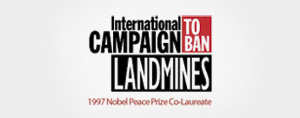09 November 2009
Press Release
Landmine Monitor Report 2009 Release
EMBARGOED UNTIL 10:30 GMT, 12 NOVEMBER 2009
ANTI-LANDMINE TREATY WORKING, LIVES AND LIMBS SAVED
According to Landmine Monitor Report 2009 released today
GENEVA, 12 November 2009 – Since the 1997 Mine Ban Treaty entered into force ten years ago, significant progress has been made in eradicating antipersonnel mines, but much work remains, according to Landmine Monitor Report 2009: Toward a Mine-Free World, a report by the International Campaign to Ban Landmines being released today at the United Nations.
Global use, production, and trade of antipersonnel mines have dramatically reduced. Some 3,200km2 of land has been cleared of mines and explosive remnants of war (ERW), and new casualties each year declined significantly to 5,197 recorded casualties in 2008. Yet serious challenges remain, with more than 70 states still mine-affected today, and assistance to mine survivors falling short of what is needed.
“The norm against mine use is firmly taking hold,” said Steve Goose of Human Rights Watch, Landmine Monitor’s Ban Policy Editor, “Antipersonnel mines have been stigmatized as an unacceptable weapon worldwide, including by countries that remain outside the Mine Ban Treaty.” Eighty percent of the world’s states are party to the Mine Ban Treaty. Thirty-nine countries—including China, India, Pakistan, Russia, and the United States—have yet to join the treaty, but most are in de facto compliance with many of the treaty’s key provisions. In recent years, Myanmar and Russia are the only states using antipersonnel mines. Use by non-state armed groups decreased from a high of 19 countries in 2001 to seven countries in 2008.
Production has decreased, with 38 countries formally halting mine production, leaving only 13 countries as potential producers. No trade between states has been confirmed since 1999. For the past decade, global trade in antipersonnel mines has consisted solely of a low-level of illicit and unacknowledged transfers.
Over the past decade, States Parties have destroyed 44 million stockpiled antipersonnel mines. Ethiopia, Indonesia, and Kuwait completed stockpile destruction in 2008–2009. While 86 States Parties have completed destruction of their stockpiled mines, three states—Belarus, Greece, and Turkey—missed their stockpile destruction deadlines in 2008 and remained in serious violation of the treaty as of November 2009.
Since 1999, clearance operations have saved millions of lives through the removal of more than 2.2 million emplaced antipersonnel mines, 250,000 antivehicle mines, and 17 million ERW from an area twice the size of London (3,200km2) in over 90 countries and areas. In 2008, mine action programs cleared an area the size of Brussels (160km2), the highest annual clearance total ever recorded by Landmine Monitor. In 2009, Tunisia became the 11th State Party to complete its clearance obligations under the treaty. Even states that have not yet joined, such as Lebanon, Nepal, and Sri Lanka, have been carrying out significant mine clearance operations.
However, ensuring States Parties fulfill their treaty-mandated mine clearance obligations is proving to be a formidable challenge. According to Stuart Casey-Maslen of Norwegian People’s Aid, Landmine Monitor’s Mine Action Editor, “Fifteen states with mine clearance treaty deadlines in 2009 were granted extensions of up to 10 years to complete clearance, though some, such as the United Kingdom and Venezuela, exerted little effort to meet their original deadlines.” The extension requests of four more States Parties with deadlines in 2009 and 2010 will be considered at the treaty’s Second Review Conference.
Although casualty rates have decreased steadily over the past decade, the total number of casualties is still far too high. From 1999–2008 Landmine Monitor identified 73,576 casualties in 119 countries/areas. Data collection is poor in many countries so the actual number of casualties is likely far higher. “The Mine Ban Treaty has led to lives and limbs saved over the past decade,” said Jacqueline Hansen, Landmine Monitor’s Program Manager, “in the next decade more countries must meet their clearance obligations and efforts to educate affected communities about mine hazards should be sustained to ensure no more people are killed or injured by these indiscriminate weapons.”
“Victim assistance has made the least progress of the major mine action sectors over the last decade, with both funding and the provision of assistance falling short of what is needed,” said Stan Brabant of Handicap International, a Landmine Monitor Editorial Board member. “Progress in the most affected states has been variable, with some countries actively engaged, and others hardly at all. Hundreds of thousands of people need more and better assistance, and they need it now.”
International support for mine action totaled US$517.8 million in 2008. Funds came from 23 countries and the European Commission (EC). The top five donors were the EC, the US, Japan, Canada, and Norway, while the top five recipients were Afghanistan, Sudan, Iraq, Lebanon, and Cambodia. More than $4 billion has been allocated to mine action since 1999.
Landmine Monitor is the research and monitoring program of the Nobel Peace Prize-winning International Campaign to Ban Landmines. Each year since 1999 Landmine Monitor has reported on the humanitarian consequences of landmines, cluster munitions, and other ERW and scrutinized implementation of and compliance with the 1997 Mine Ban Treaty. Landmine Monitor Report 2009 reports on ban policy, demining, casualties, risk education, victim assistance and support for mine action in every country in the world and eight other areas not internationally recognized as states. It also includes a special ten-year review of progress since the entry into force of the Mine Ban Treaty in 1999.
This report is being released in advance of the Second Review Conference of the Mine Ban Treaty, the Cartagena Summit on a Mine-Free World, to be held in Colombia from 29 November–4 December.
Landmine Monitor is coordinated by an Editorial Board drawn from five organizations: Mines Action Canada, Handicap International, Human Rights Watch, Landmine Action, and Norwegian People’s Aid. It constitutes a sustainable and systematic way for NGOs to monitor and report on the implementation of humanitarian and disarmament treaties.
Landmine Monitor Report 2009 and related documents are available at 01:00 GMT here on 12 November.
For more information or to schedule an interview contact:
- Ms. Jacqueline Hansen, Landmine Monitor Program Manager, Geneva (GMT+1), Mobile +41-78-606-94-68 or +1-613-851-5436, email jackie@icbl.org
- Ms. Amelie Chayer, ICBL Communications Officer, Geneva (GMT+1), Mobile +41-78-728-53-20 or +33-6-89-55-12-81, email amelie@icbl.org



